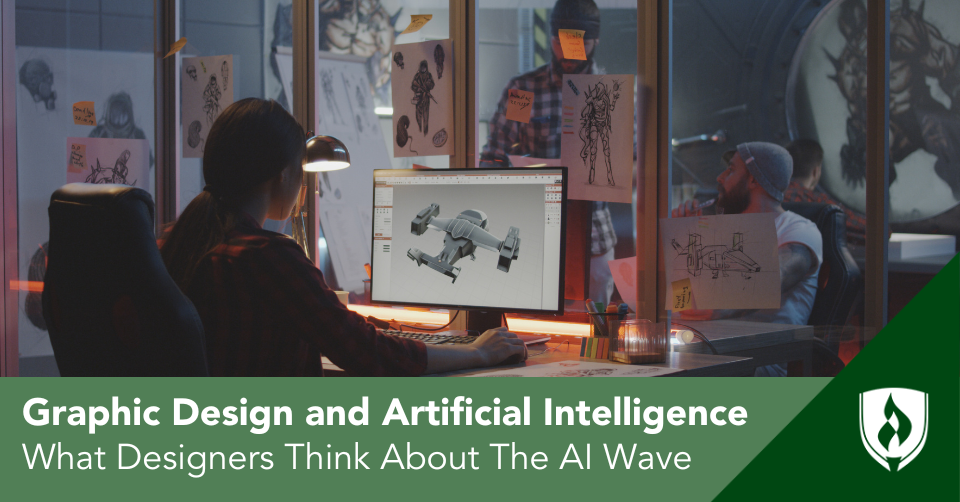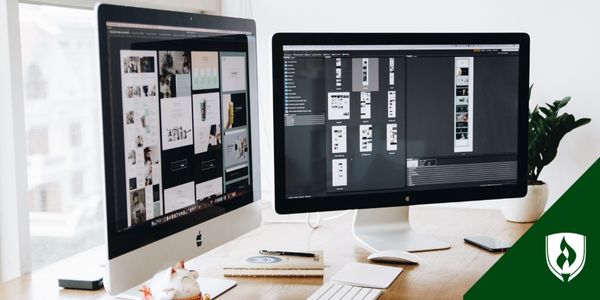Graphic Design and Artificial Intelligence: What Designers Think About The AI Wave
By Robbie Gould on 08/17/2023

The growing popularity of artificial intelligence (AI) has stirred up a mix of excitement, curiosity, and even trepidation among creative professionals, and graphic designers are no exception.
As AI and machine learning infiltrate every aspect of our lives, the design industry finds itself at a crossroads, studying and debating the potential implications of this revolutionary technology. Will AI be the long-awaited muse that elevates creativity to new heights? Or is it a harbinger of job displacement and a loss of the human touch in design?
“As a graphic designer with a keen eye on technological advancements, I am excited and optimistic about the future of AI in the realm of graphic design,” says graphic designer Charles David Gross. “The integration of AI tools and algorithms will undoubtedly revolutionize the creative process.”
If you want to become a graphic designer, and you're worried AI is going to commandeer the industry from humans, read on! This topic can be so much more interesting than a simple takeover.
Graphic designers vs. AI design: Addressing the concerns
First and foremost, AI is unlikely to rob you of a graphic design career.1
Students and graphic designers alike have concerns about artificial intelligence entering the graphic design industry, so you're not alone. You might worry about job security in the graphic design world. But one thing to consider is that almost everyone has access to AI image-generating tools. And these tools typically rely on a generic mix of elements gathered in huge quantities.
"It's like having a cookie-making robot that bakes generic, run-of-the-mill but tasty cookies – it gets the job done and pleases the uninitiated," Gross says. "But it's not made with love. It lacks attention to detail, variability, and nuance – emotional connection and other intangibles – and the same goes for the AI graphic design tools. It can get the job done, sure, but it won't ever compete with Grandma's cookies."
Will companies want their images to be essentially the same as what any random person out there could create? Will consumers notice an appreciable difference over time, impacting the bottom line and pushing employers to seek new ways of differentiation?
Designers have several ethical concerns as well.1 These concerns vary from algorithms perpetuating biases, originality and plagiarism to privacy, data security and accountability.1, 2
Identifying, understanding and addressing these concerns is vital to ensuring the safe, inclusive integration of AI into the graphic design field. It’s why talented graphic designers are needed now more than ever. They are the ones with the expertise and training to assess these concerns and hopefully propose solutions.
The role of designers in shaping AI tools
With the advent of AI, the duties of a graphic designer just got a lot more interesting. Now, many designers have an essential responsibility to actively participate in AI-related discussions to ensure that AI tools and applications align with ethical design principles and other integral elements of the creative process.3
Here's a list of some of the key roles that designers are now involved in taking on to help shape AI.
1. Designing AI user interfaces
Graphic designers can be tasked with creating user-friendly interfaces for AI-powered design tools. They can make sure that using AI tools is easy-peasy for both designers and non-designers. So, designers can help develop an intuitive, user-friendly interface that is simple to navigate and effective in getting design jobs done.
2. Training and feedback for AI models
Graphic designers’ expertise in design principles, aesthetics, and quality can help fine-tune AI tools, improving the accuracy and relevance of AI-generated designs. It is vital that trained designers remain involved in education and training and provide consistent feedback as AI design elements continue to evolve.
3. Defining AI design guidelines
Graphic design pros need to ensure that any AI design aligns with brand identity, client requirements and ethical standards. Ideally, most designers will have had a hand in establishing guidelines, processes and principles for AI design use.
4. Collaborating with AI developers
Designers can work collaboratively with software developers and data scientists to understand the capabilities and limitations of AI design tools. Ultimately, that work could improve the performance of various tasks and AI tools. If graphic designers spot a need, they can then work with developers to create a specific AI graphic design tool to address that need.
Designers will need to work with software developers to ensure that AI remains a tool for empowerment, enhancing their creativity rather than diminishing their roles.
5. Advocating an ethical use of AI
Graphic design professionals can play a critical role in actively addressing all sorts of ethical issues. Most importantly, designers will need to promote and advocate for inclusion, diversity, and equity. They will continue to have a supreme responsibility to accommodate individuals whose voice isn't loud.
Also, they will need to become active in pursuing fairness regarding potential issues such as privacy, creative ownership, transparency, and accessibility.
Design professionals can play a vital role in demystifying AI by educating their peers, clients and the public about AI’s potential in the design process. By advocating for responsible and safe AI use, designers can make AI more accessible and easier to understand for everyone, thereby encouraging its mainstream adoption.
AI as a creative assistant – not a replacement
Artificial intelligence is proving to be an invaluable creative assistant for graphic design and other creative professionals, rather than a replacement.4
With the help of AI, designers can breeze through repetitive tasks and free up more of their time for the important stuff. An AI tool can be great for speeding up design workflows and increasing production.
It can also be an interesting tool for creative prompts and inspiration. By analyzing vast databases of design trends, styles, and visual elements, AI can present fresh ideas and unique combinations designers might not have otherwise considered.5
AI's role as a creative assistant can complement and enhance the work of graphic designers, possibly elevating the design process to new heights. While AI can handle automating tasks and offer design suggestions, it cannot replace the human touch and emotional depth that designers bring to their work.
How graphic design pros can use AI design tools now
By incorporating AI into their workflows, graphic design pros can streamline tasks, find inspiration and explore new design possibilities. Ultimately, that will enhance their creativity and productivity in the ever-evolving world of design.5
Here are some common ways graphic design professionals currently leverage AI.
Image editing and enhancement
Image editing tools powered by AI automatically improve images by adjusting brightness, contrast and colors, as well as removing any imperfections. This improvement not only saves designers time but also results in more polished, professional-looking images.
Layout generation
AI can assist in generating layout options for various design projects, such as posters, websites or social media graphics. By analyzing design trends and user preferences, AI can suggest layout compositions that designers can use as a starting point for their work.
Color palette selection
AI can recommend color palettes based on the content or theme of a design project. These suggestions help designers find harmonious color combinations more quickly and explore different possibilities with the click of a button.
Typography and font selection
By analyzing the content and style of a project, AI algorithms can suggest appropriate fonts and typography choices. As a result, designers save more time and effort when they manually search for the perfect fonts for a project.
Customizable design templates
Design platforms powered by AI provide designers with customizable templates, making it easier and faster to create and adapt designs for specific projects. Those projects may include business cards, social media posts or presentations.
Data visualization
AI can help designers create complex data visualizations and infographics from raw data, making it easier to effectively communicate complex information.
Personalization and dynamic content
AI also enables designers to craft personalized designs that cater to individual user data and preferences, resulting in more engaging and relevant content creation.
Automated text and image analysis
Design pros can analyze and extract content from both images and text using AI tools. This analysis can help designers to efficiently organize information.
Predictive design
AI algorithms can analyze past design data and user behavior to predict design preferences. As a result, designers can better anticipate user needs and create more effective designs.
AI limitations in creativity and originality
While artificial intelligence has brought significant advancements to graphic design, AI does have its limitations.
AI-generated designs may lack the depth of creativity and originality that man-made designs provide, because AI often relies on existing trends and styles rather than producing innovative, unique designs. AI also lacks emotional intelligence and the ability to understand human emotions and experiences. This lack of emotional intelligence often results in designs that feel impersonal and miss the emotional connection that human-created products evoke.
Contextual understanding and cultural nuances can also be challenging for AI, making it difficult for AI tools to design effectively for specific audiences or diverse communities. Ethical concerns arise when AI tools are trained on biased or unethical data, leading to designs that perpetuate stereotypes or promote harmful content.
Another constraint of AI lies in its ability to handle complex problem-solving and grasp abstract concepts, both of which are essential in certain graphic design projects.5 Replicating human intuition and subjective judgment accurately is challenging for AI, and it may not fully comprehend design strategy and storytelling.
Despite these limitations, AI remains a valuable tool for graphic designers. It can offer efficiency, inspiration and data-driven insights. AIso, AI can enhance the design process when it is combined with the human touch and creativity that make design uniquely impactful.
Can graphic designers harness the AI wave?
AI can be an incredibly powerful tool, and it is truly an impressive achievement. However, there are still many kinks that need ironing out and regulations that need definition. If you're still worried about AI commandeering your graphic design career, consider instead how you can utilize AI to assist you.
Graphic designers can treat an AI tool the same way they treat other graphic design tools. Your human touch and unique perspective can’t be mass-produced in moments.
Plus, having some familiarity with how to use AI in your work might be a nice thing to showcase in a future job interview. The expanded functions of AI might very well broaden the types of work graphic designers do, allowing for new, interesting specializations and jobs.
Check out What Can You Do with a Graphic Design Degree? Exploring Your Options for a few ideas of where education in graphic design could take you.
1S Makin. LinkedIn. Will AI replace Graphic Designers? Date accessed: 7/19/23. https://www.linkedin.com/pulse/ai-replace-graphic-designers-sean-makin/
2R Heilweil. Vox. Why algorithms can be racist and sexist. Date accessed: 7/19/23. https://www.vox.com/recode/2020/2/18/21121286/algorithms-bias-discrimination-facial-recognition-transparency
3L Passas. LinkedIn. The Ethics of AI in Design: Balancing Creativity and Responsibility. Date accessed 7/19/23. https://www.linkedin.com/pulse/ethics-ai-design-balancing-creativity-responsibility-iordanis-passas/
4J Dang. The Mercury News. Artists using artificial intelligence as a creative partner. Date accessed: 7/19/23. https://www.mercurynews.com/2023/06/26/artists-using-artificial-intelligence-as-a-creative-partner/
5Creatophix. LinkedIn. Impact of AI on Graphic Designing. Date accessed: 7/19/23. https://www.linkedin.com/pulse/impact-ai-graphic-designing-creatophix/




